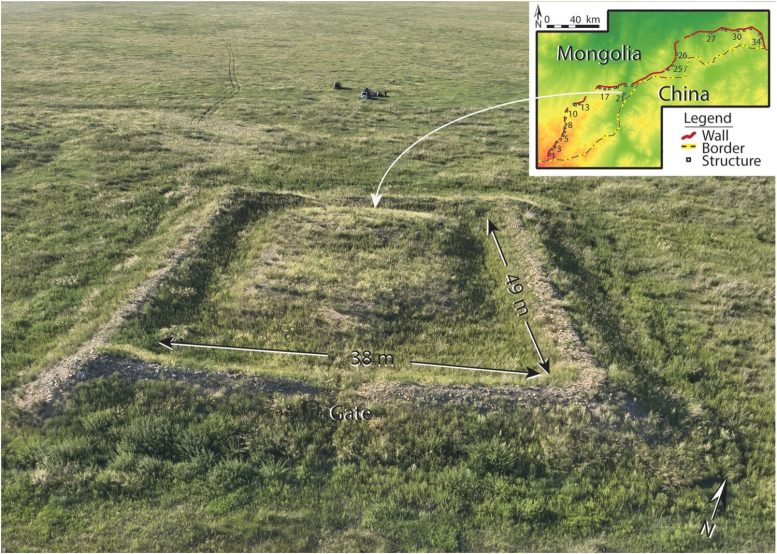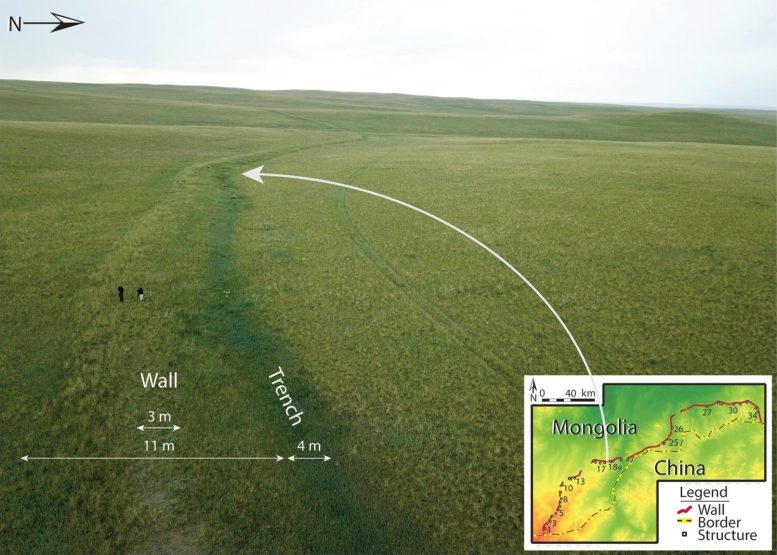
A new study highlights the discovery of the Mongolian Arc, a 405-kilometer wall system in eastern Mongolia, revealing its architectural significance and prompting questions about its construction, purposes, and impacts. This research, part of a larger project examining historical wall systems, offers fresh insights into ancient civilizations and their legacies. Above is a drone photo of Khaltaryn Balgas. Credit: Authors
A recent study sheds light on the Mongolian Arc, a significant wall system extending over 405 kilometers in eastern Mongolia, that had previously remained overlooked. This finding uncovers the importance of this ancient architectural wonder and raises important inquiries regarding the reasons behind its construction, its purpose, and the wider consequences of these massive structures.
Their findings contribute to a larger multidisciplinary project exploring historical wall systems and their socio-political, economic, and environmental impacts, marking a pivotal milestone in understanding ancient civilizations and their enduring legacies.
Discovery and Investigation
Prof. Gideon Shelach-Lavi from Hebrew University and Prof. Amartuvshin Chunag from the National University of Mongolia, and their team unveil a new discovery in their latest research published in the Journal of Field Archaeology. Their paper sheds light on a monumental wall system that has remained largely overlooked in existing academic discourse.

The wall section is located between structures 17 and 18. Measurements are typical based on measurements at various locations along the wall. Credit: Authors
The “Mongolian Arc,” spanning 405 kilometers in eastern Mongolia, comprises an earthen wall, a trench, and 34 accompanying structures. Constructed between the 11th and 13th centuries a.d., this intricate system has emerged as a pivotal yet understudied facet of historical architectural marvels.
The research, conducted through a collaborative effort, involved a comprehensive approach combining remote sensing data collection, archaeological field surveys, and analysis through geographic information systems (GIS). Professors Shelach-Lavi and Amartuvshin’s team also delved into ancient written sources to offer a preliminary interpretation of the design and potential functions of the Mongolian Arc.
Significance and Broader Implications
“Understanding the significance of the Mongolian Arc unlocks profound insights into medieval wall systems, raising pertinent questions about the motives, functionality, and enduring consequences of such colossal constructions,” remarked Prof. Gideon Shelach-Lavi.
This study is part of a larger multidisciplinary project, funded by a generous research fund from the European Research Council (ERC) addressing the construction of extensive walls and structures in northern China and eastern Mongolia during the 11th–13th centuries A.D. The findings not only contribute to unraveling historical mysteries but also offer a framework for exploring the broader socio-political, economic, and environmental impacts of such endeavors.
The published paper marks a pivotal milestone in the ongoing investigation, sparking renewed interest and further inquiry into ancient architectural wonders and their societal implications.
Reference: “Unraveling the Mongolian Arc: a Field Survey and Spatial Investigation of a Previously Unexplored Wall System in Eastern Mongolia” by Ying Tung Fung, Angaragdulguun Gantumur, Ido Wachtel, Amartuvshin Chunag, Zhidong Zhang, Or Fenigstein, Dan Golan and Gideon Shelach-Lavi, 27 December 2023, Journal of Field Archaeology.
DOI: 10.1080/00934690.2023.2295198
The study was funded by the HORIZON EUROPE European Research Council.









Be the first to comment on "The Great Wall of Mongolia: Scientists Unearth 405 Kilometer Enigma"